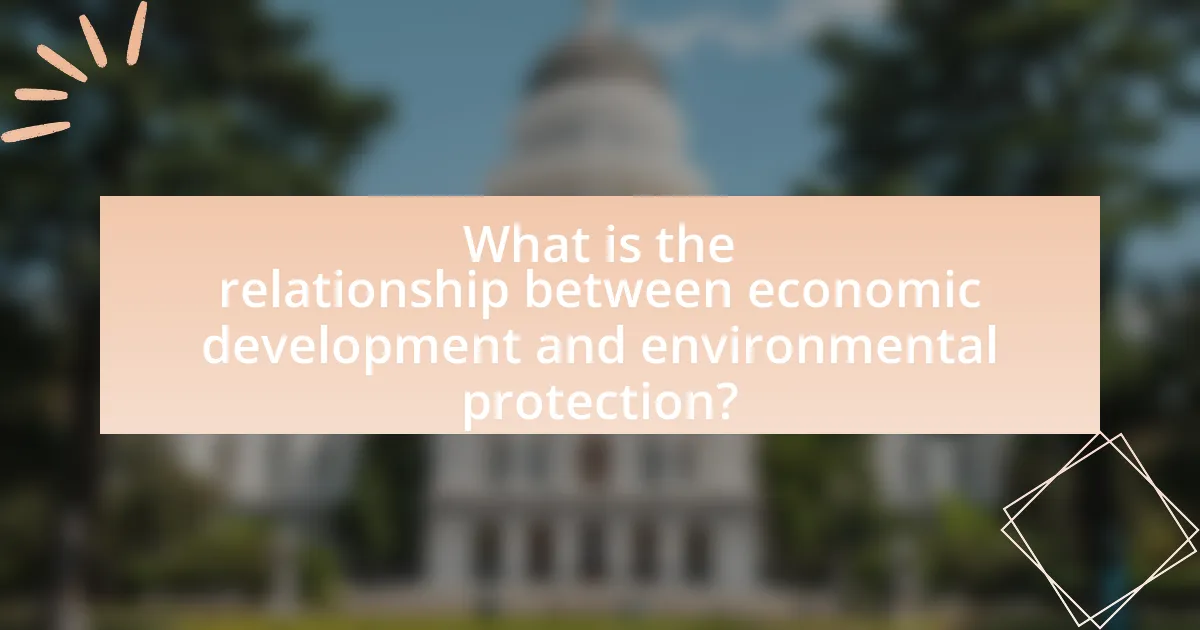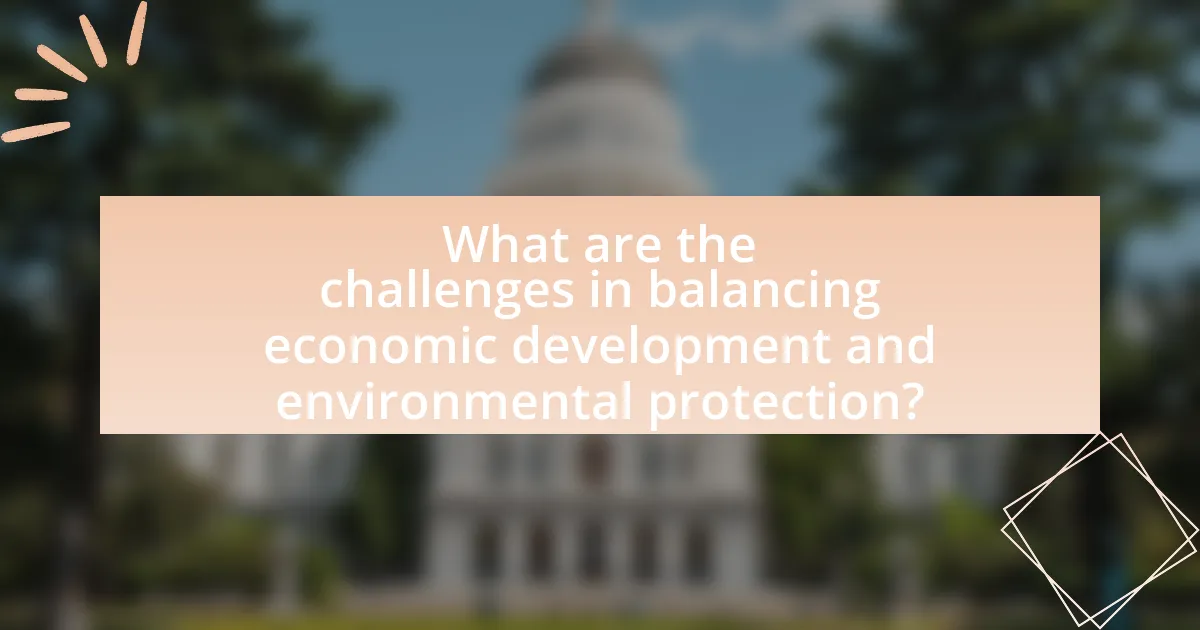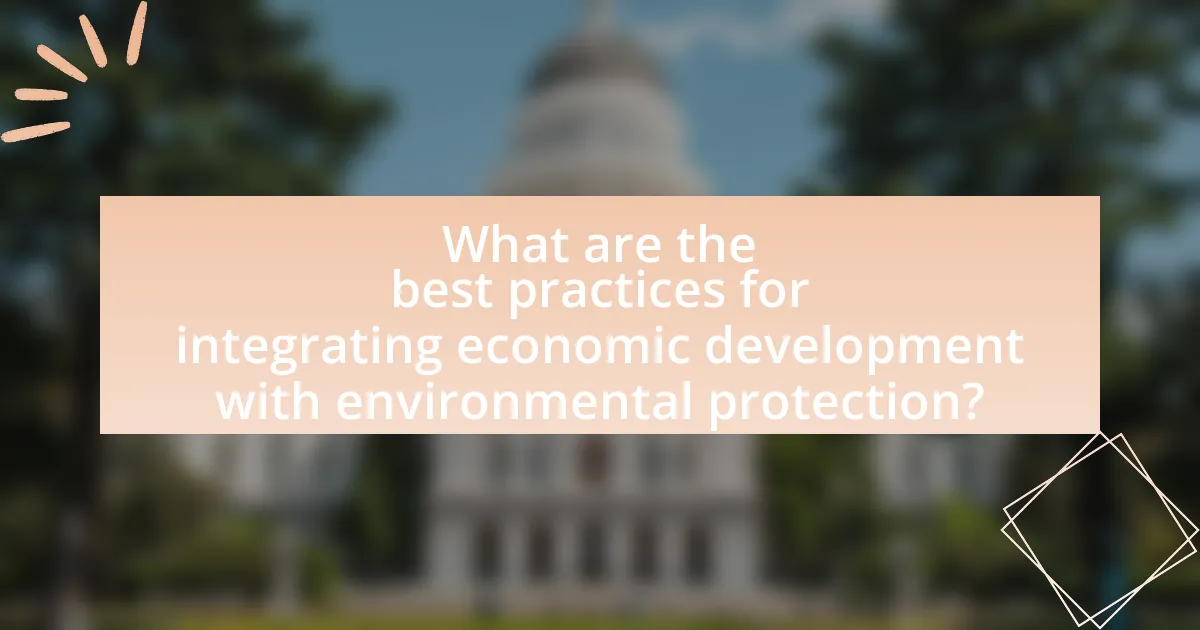The article analyzes the intricate relationship between economic development and environmental protection, highlighting how these two domains interact and influence each other. It discusses the potential for sustainable economic practices, such as green technologies and renewable energy investments, to foster economic growth while safeguarding the environment. Key factors influencing this relationship include regulatory frameworks, technological advancements, and public awareness. The article also examines the challenges and conflicts that arise when prioritizing short-term economic gains over long-term environmental health, emphasizing the importance of integrating sustainable practices into economic planning to achieve mutually beneficial outcomes.

What is the relationship between economic development and environmental protection?
Economic development and environmental protection are interconnected, as economic growth can lead to environmental degradation if not managed sustainably. For instance, industrialization often increases pollution and resource depletion, negatively impacting ecosystems. However, sustainable economic development practices, such as green technologies and renewable energy investments, can enhance environmental protection while fostering economic growth. Research indicates that countries prioritizing sustainable practices, like Denmark and Sweden, have successfully balanced economic growth with environmental stewardship, demonstrating that it is possible to achieve both objectives simultaneously.
How do economic development and environmental protection interact?
Economic development and environmental protection interact through a complex relationship where growth initiatives can either harm or enhance environmental sustainability. Economic activities, such as industrialization and urbanization, often lead to increased pollution and resource depletion, negatively impacting ecosystems. Conversely, sustainable economic practices, such as green technology and renewable energy investments, can promote environmental protection while fostering economic growth. For instance, a report by the United Nations Environment Programme highlights that transitioning to a green economy could generate millions of jobs and reduce carbon emissions, demonstrating that economic development can align with environmental goals when approached sustainably.
What are the key factors influencing this relationship?
The key factors influencing the relationship between economic development and environmental protection include regulatory frameworks, technological advancements, public awareness, and economic incentives. Regulatory frameworks establish the legal standards that govern environmental practices, which can either promote or hinder economic growth. For instance, countries with stringent environmental regulations often see innovation in green technologies, which can lead to sustainable economic development. Technological advancements, such as renewable energy solutions, enable industries to reduce their environmental impact while maintaining productivity. Public awareness and advocacy for environmental issues can drive policy changes and corporate responsibility, influencing how businesses operate in relation to environmental sustainability. Economic incentives, such as subsidies for clean energy or penalties for pollution, can motivate businesses to adopt environmentally friendly practices, thereby aligning economic growth with environmental protection. These factors collectively shape how economic development interacts with environmental sustainability, demonstrating that a balanced approach can lead to mutually beneficial outcomes.
How do different economic models impact environmental outcomes?
Different economic models significantly impact environmental outcomes by influencing resource allocation, consumption patterns, and regulatory frameworks. For instance, market-based models often prioritize profit maximization, which can lead to over-exploitation of natural resources and increased pollution, as seen in industrialized nations where deregulation has resulted in environmental degradation. Conversely, sustainable economic models, such as circular economy frameworks, emphasize resource efficiency and waste reduction, leading to improved environmental quality. Research by the World Bank indicates that countries adopting green growth strategies can achieve economic growth while reducing carbon emissions, demonstrating that the choice of economic model directly correlates with environmental sustainability.
Why is it important to analyze this relationship?
Analyzing the relationship between economic development and environmental protection is crucial because it helps identify sustainable practices that balance growth with ecological preservation. Understanding this relationship allows policymakers to create strategies that promote economic growth while minimizing environmental degradation. For instance, research by the World Bank indicates that countries that integrate environmental considerations into their economic planning experience more sustainable growth, demonstrating that economic and environmental goals can be aligned effectively.
What are the potential consequences of neglecting environmental protection in economic development?
Neglecting environmental protection in economic development can lead to severe consequences, including ecological degradation, health risks, and economic instability. Ecological degradation manifests through loss of biodiversity, deforestation, and pollution, which disrupt ecosystems and diminish natural resources essential for sustainable development. Health risks arise from increased air and water pollution, contributing to respiratory diseases and other health issues, as evidenced by the World Health Organization reporting that air pollution causes approximately 7 million premature deaths annually. Economic instability can occur as environmental disasters, such as floods and droughts, become more frequent due to climate change, leading to significant financial losses and undermining economic growth. These consequences highlight the critical need for integrating environmental protection into economic development strategies to ensure long-term sustainability and public health.
How can understanding this relationship inform policy decisions?
Understanding the relationship between economic development and environmental protection can inform policy decisions by highlighting the need for sustainable practices that balance growth with ecological preservation. Policymakers can utilize this understanding to create regulations that promote green technologies and renewable energy, which have been shown to stimulate economic growth while reducing environmental degradation. For instance, a study by the International Renewable Energy Agency found that transitioning to renewable energy could create 24 million jobs globally by 2030, demonstrating that environmental policies can drive economic benefits. Thus, informed policy decisions can lead to a synergistic approach that fosters both economic advancement and environmental sustainability.

What are the challenges in balancing economic development and environmental protection?
The challenges in balancing economic development and environmental protection include resource allocation, regulatory conflicts, and public perception. Resource allocation often leads to prioritizing short-term economic gains over long-term environmental sustainability, resulting in depletion of natural resources and habitat destruction. Regulatory conflicts arise when economic policies favor industrial growth at the expense of environmental regulations, leading to pollution and ecological degradation. Public perception can complicate this balance, as communities may resist environmental protections that they perceive as hindering economic opportunities, despite evidence showing that sustainable practices can lead to long-term economic benefits. For instance, a study by the World Bank indicates that countries investing in green technologies can achieve economic growth while reducing carbon emissions, highlighting the potential for synergy between development and environmental stewardship.
What are the common conflicts between economic growth and environmental sustainability?
Common conflicts between economic growth and environmental sustainability include resource depletion, pollution, and habitat destruction. Economic growth often relies on the extraction and consumption of natural resources, leading to overexploitation and degradation of ecosystems. For instance, industrial activities contribute significantly to air and water pollution, which can harm public health and biodiversity. Additionally, urban expansion and infrastructure development frequently result in habitat loss, threatening wildlife and disrupting ecological balance. According to the United Nations Environment Programme, unsustainable economic practices can lead to a 50% increase in greenhouse gas emissions by 2030, exacerbating climate change and further complicating the pursuit of sustainable development.
How do short-term economic gains affect long-term environmental health?
Short-term economic gains often lead to detrimental long-term environmental health by prioritizing immediate profit over sustainable practices. For instance, industries may exploit natural resources without considering the ecological consequences, resulting in habitat destruction, pollution, and depletion of biodiversity. A study by the World Bank indicates that countries focusing on rapid industrialization without environmental regulations face significant long-term costs, including increased health care expenses and loss of ecosystem services, which can exceed the initial economic benefits. Thus, while short-term economic activities may boost GDP, they can compromise the environment, leading to adverse effects on public health and ecological stability over time.
What role do industries play in this conflict?
Industries significantly contribute to the conflict between economic development and environmental protection by prioritizing profit over sustainability. This prioritization often leads to environmental degradation, as industries exploit natural resources, emit pollutants, and contribute to climate change. For instance, the manufacturing sector is responsible for approximately 20% of global greenhouse gas emissions, highlighting its impact on environmental health. Additionally, industries may lobby against environmental regulations to maintain operational flexibility, further exacerbating the conflict. This dynamic illustrates how industrial activities can undermine efforts to achieve sustainable development while pursuing economic growth.
How can these challenges be addressed?
To address the challenges between economic development and environmental protection, implementing sustainable practices is essential. Sustainable practices, such as green technology adoption and renewable energy investment, can reduce environmental impact while promoting economic growth. For instance, a study by the International Renewable Energy Agency found that transitioning to renewable energy could create 24 million jobs globally by 2030, demonstrating that economic development can align with environmental sustainability. Additionally, integrating environmental regulations into economic policies ensures that growth does not compromise ecological integrity, as seen in countries like Sweden, which has successfully balanced economic growth with stringent environmental protections.
What strategies can promote sustainable economic development?
Strategies that can promote sustainable economic development include investing in renewable energy, implementing sustainable agricultural practices, and enhancing public transportation systems. Investing in renewable energy, such as solar and wind, reduces reliance on fossil fuels and lowers greenhouse gas emissions, contributing to environmental protection while creating jobs. Sustainable agricultural practices, like organic farming and permaculture, improve soil health and biodiversity, ensuring food security and reducing environmental degradation. Enhancing public transportation systems decreases traffic congestion and pollution, promoting efficient resource use and improving urban air quality. These strategies collectively support economic growth while safeguarding the environment, as evidenced by studies showing that countries adopting green technologies experience higher economic resilience and job creation.
How can technology contribute to resolving these challenges?
Technology can significantly contribute to resolving the challenges between economic development and environmental protection by enabling sustainable practices and enhancing resource efficiency. For instance, renewable energy technologies, such as solar and wind power, reduce reliance on fossil fuels, thereby decreasing greenhouse gas emissions and promoting cleaner air. According to the International Renewable Energy Agency, the global renewable energy sector employed over 11 million people in 2018, demonstrating that economic growth can occur alongside environmental sustainability. Additionally, advancements in smart agriculture, such as precision farming, optimize resource use, minimize waste, and increase crop yields, which supports food security while protecting ecosystems. These examples illustrate how technology can bridge the gap between economic growth and environmental stewardship.

What are the best practices for integrating economic development with environmental protection?
The best practices for integrating economic development with environmental protection include adopting sustainable development principles, implementing green technologies, and engaging stakeholders in decision-making processes. Sustainable development principles ensure that economic growth does not compromise environmental integrity, as evidenced by the United Nations’ Sustainable Development Goals, which emphasize the balance between economic, social, and environmental dimensions. Utilizing green technologies, such as renewable energy sources and energy-efficient practices, can reduce environmental impact while promoting economic growth; for instance, the International Renewable Energy Agency reported that renewable energy sectors created 11.5 million jobs globally in 2018. Engaging stakeholders, including local communities and businesses, fosters collaboration and ensures that development projects consider environmental impacts, as demonstrated by successful public-private partnerships in various regions that have led to both economic and environmental benefits.
What successful models exist for sustainable development?
Successful models for sustainable development include the Circular Economy, the Sustainable Development Goals (SDGs), and the Eco-Industrial Park model. The Circular Economy emphasizes resource efficiency and waste reduction by promoting recycling and reuse, which has been shown to reduce environmental impact while fostering economic growth. The SDGs, established by the United Nations, provide a comprehensive framework for addressing global challenges, integrating economic, social, and environmental dimensions, with 193 countries committed to achieving these goals by 2030. The Eco-Industrial Park model encourages collaboration among businesses to optimize resource use and minimize waste, exemplified by the Kalundborg Symbiosis in Denmark, where companies share resources and by-products, leading to economic and environmental benefits. These models demonstrate effective strategies for harmonizing economic development with environmental protection.
How have different countries approached this integration?
Different countries have approached the integration of economic development and environmental protection through various strategies tailored to their unique contexts. For instance, Germany has implemented a strong regulatory framework that emphasizes renewable energy and sustainability, leading to a significant reduction in carbon emissions, with a 40% decrease from 1990 levels by 2020. In contrast, China has focused on rapid industrialization while increasingly investing in green technologies, resulting in the world’s largest market for solar energy, which accounted for 30% of global installations in 2020. Meanwhile, Costa Rica has prioritized environmental conservation as a core component of its development strategy, achieving over 99% of its electricity from renewable sources and reforesting more than half of its land since the 1980s. These examples illustrate how different nations have tailored their approaches to balance economic growth with environmental sustainability.
What lessons can be learned from these models?
The primary lesson learned from models analyzing the relationship between economic development and environmental protection is that sustainable practices can lead to long-term economic benefits. These models demonstrate that integrating environmental considerations into economic planning can enhance resource efficiency and reduce costs associated with environmental degradation. For instance, research shows that countries investing in green technologies often experience higher rates of economic growth, as seen in the case of Denmark, which has become a leader in wind energy and has seen significant job creation in this sector. This evidence supports the notion that prioritizing environmental sustainability can yield both ecological and economic advantages.
What role do stakeholders play in this integration?
Stakeholders play a crucial role in the integration of economic development and environmental protection by influencing decision-making processes and ensuring that diverse interests are represented. They include government agencies, businesses, non-governmental organizations, and local communities, each contributing unique perspectives and resources. For instance, government agencies can establish regulations that promote sustainable practices, while businesses can adopt eco-friendly technologies that enhance economic growth. Research indicates that stakeholder engagement leads to more effective policies, as seen in the 2015 Paris Agreement, where various stakeholders collaborated to address climate change, demonstrating that inclusive approaches yield better outcomes for both economic and environmental objectives.
How can businesses contribute to sustainable practices?
Businesses can contribute to sustainable practices by implementing eco-friendly operations, reducing waste, and promoting renewable resources. For instance, companies can adopt energy-efficient technologies, which can lead to a reduction in carbon emissions; a study by the International Energy Agency found that energy efficiency improvements could reduce global energy demand by 12% by 2040. Additionally, businesses can engage in sustainable sourcing, ensuring that materials are obtained from environmentally responsible suppliers, which supports biodiversity and reduces environmental degradation. By integrating these practices, businesses not only enhance their corporate social responsibility but also align with global sustainability goals, such as those outlined in the United Nations Sustainable Development Goals.
What is the importance of community involvement in environmental protection efforts?
Community involvement is crucial in environmental protection efforts as it fosters local stewardship and enhances the effectiveness of conservation initiatives. Engaged communities are more likely to participate in sustainable practices, advocate for environmental policies, and contribute to local ecological restoration projects. Research indicates that community-led initiatives can lead to a 30% increase in the success rates of conservation efforts, as local knowledge and commitment drive more tailored and effective solutions. Furthermore, when communities are involved, they often develop a stronger sense of ownership over their environment, which can lead to long-term behavioral changes that benefit both the ecosystem and economic development.
What practical steps can be taken to achieve a balance between economic development and environmental protection?
To achieve a balance between economic development and environmental protection, implementing sustainable practices is essential. This includes adopting renewable energy sources, which can reduce greenhouse gas emissions while fostering economic growth; for instance, the International Renewable Energy Agency reported that renewable energy jobs reached 11.5 million globally in 2018, demonstrating economic potential. Additionally, enforcing stricter environmental regulations can ensure that industries minimize their ecological footprint, as seen in countries like Sweden, where stringent policies have led to both economic growth and significant reductions in carbon emissions. Promoting green technologies and sustainable agriculture can also enhance productivity while preserving natural resources, evidenced by the increase in organic farming, which has grown by 20% annually in many regions. These steps collectively contribute to a sustainable economic framework that prioritizes both development and environmental integrity.